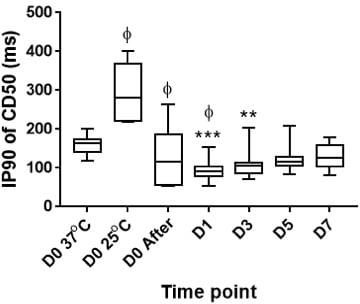Cell-cell and cell-substrate interactions can alter the contractile behaviour of human induced pluripotent stem cell-derived cardiomyocytes (hiPSC-CM). HiPSC-CM are often cultured on rigid standard tissue culture plastic (TCP) in 2D sheets, in contrast to the more flexible 3D extracellular matrix of the myocardium. We investigated contractile behaviour of hiPSC-CM microtissues (MT) before (2D), during and after detachment (3D) from TCP. Spontaneously beating hiPSC-CM were seeded on thermosensitive Nunc UpCell plates (3 experiments, 3-7 MT per experiment). On day 0, after plates were cooled to 25°C, MT were lifted off the dish and transferred to a standard TCP dish. Video recordings of the MT were made before transfer at 37°C (D037) and 25°C (D025), directly after transfer (D0) and on days 1, 3, 5 and 7 after transfer (D1-7). Video frames were subdivided into a 30×30 grid, and each grid square analysed using MUSCLEMOTION (Sala et al., 2018). The percentage of grid squares with single and multiple transient peaks was calculated, and the ranges of start times (TStart) and contraction durations at 50% (CD50) were characterised by the 10-90th percentile difference (IP90). Values are reported as mean ranks±SD, and time points were compared to D037, using Kruskal-Wallis and Dunn’s multiple comparisons tests. After detachment, the MT-diameter decreased from ~3mm to 0.5-1mm as the structure became more 3D-like. Before detachment (D037), the percentage of transients with multiple peaks was 50±13% (Fig 1). Multiple peaks became rarer during and after detachment (D025: 43±13%; D0: 13±17%), but this trend reversed during reattachment to TCP on D1-7 (D1: 27±15%; D7: 54±17%) (Fig 1). The range of CD50 values on D037 and D0 were similar (IP90=159±27ms vs 128±83ms) but were significantly decreased on D1 and D3 (IP90=D1: 95±27ms; D3: 108±31ms; p<0.01) and increased during reattachment (IP90=D5: 123±32ms; D7: 130±29ms) (Fig 2). Transients with multiple peaks also had higher CD50 values (1 peak: 307±44ms; >1 peak: 348±45ms; p<0.0001), but it is unclear whether this was due to intrinsic properties of cells or to mechanical interactions between neighbouring cells. The ranges of TStart values were significantly smaller on D3-7 (IP90=D3:21±6ms, D7:20±5ms; p<0.0001) compared to D037 and D0 (IP90=42±9ms vs 40±10ms), suggesting that the 3D structure increases synchronicity of the MT independently from TCP-adhesion. In this study, for both 2D and 3D culture, hiPSC-CM cultured on TCP exhibit complex contractile behaviour which is less complicated after detachment. This highlights the importance of cell-substrate interaction and the need to consider this factor in future studies.
Physiology 2019 (Aberdeen, UK) (2019) Proc Physiol Soc 43, C016
Oral Communications: Substrate affects contractile behaviour of hiPSC derived cardiomyocytes
E. Huethorst1,2, F. L. Burton1, N. Gadegaard2, G. L. Smith1
1. Institute of Cardiovascular And Medical Sciences, University of Glasgow, Glasgow, United Kingdom. 2. Division of Biomedical Engineering, University of Glasgow, Glasgow, United Kingdom.
View other abstracts by:
Figure 1. The percentage of contractility transients with multiple peaks on different time points.
Figure 2. The IP90 range of CD50 values on different time points.
Where applicable, experiments conform with Society ethical requirements.


